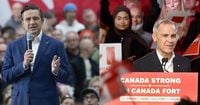Residents across Toronto and the Greater Toronto Area (GTA) flocked to the polls on April 28, 2025, to cast their votes in the highly anticipated federal election. This election is significant, especially for Ontario, as it has historically played a crucial role in determining the overall outcome of federal elections in Canada. In fact, over the past 50 years, the party that secures the most seats in Ontario has also formed the government, with only one exception.
As the polls opened at 9:30 a.m. ET and closed at 9:30 p.m. ET, voters were eager to participate in the democratic process. The election night coverage was provided live across Canada by CityNews and NewsRadio, ensuring that citizens remained informed as results began to trickle in.
In the GTA, several incumbents were re-elected, showcasing the stability of certain ridings. Nathaniel Erskine-Smith emerged victorious in Beaches–East York, and Julie Dzerowicz secured her seat in Davenport. Other notable wins included Robert Oliphant in Don Valley West and Yvan Baker in Etobicoke Centre. Salma Zahid, Shaun Chen, and Bill Blair also retained their positions in Scarborough, further solidifying the Liberal presence in the region.
However, not all results were as straightforward. Several ridings remained undecided at the time of reporting, including Don Valley North and Eglinton–Lawrence, where the incumbents faced challenges from their opponents. The competition was fierce, particularly in areas where the Conservatives and New Democrats were vying for seats.
In Peel Region, the election results were closely watched, with Amarjeet Gill of the Conservative Party projected to win in Brampton West. With 124 of 137 polls reporting, Gill had garnered 17,416 votes, accounting for 50.08% of the total. Incumbent Kamal Khera of the Liberal Party trailed closely behind with 16,462 votes, representing 47.34%. The competition in Brampton was indicative of the larger trends across Ontario, where the stakes were high.
As the election unfolded, the political landscape in Ontario was shaped by various factors, including the recent provincial election in which Premier Doug Ford's Progressive Conservatives secured a third consecutive majority. Ford's campaign focused heavily on economic issues, particularly the impact of U.S. President Donald Trump's policies on Canada. This theme resonated with voters in Ontario, where concerns about the economy and the cost of living dominated discussions.
Liberal Leader Mark Carney and Conservative Leader Pierre Poilievre both campaigned aggressively in Ontario, with Carney mirroring Ford's strategy by emphasizing economic stability and protection against external threats. Polls indicated that the Liberals maintained a lead over the Conservatives throughout the campaign, although the margin narrowed as election day approached.
Jagmeet Singh, leader of the New Democratic Party, also made his presence felt in Ontario, returning to the province multiple times during the campaign. Singh's focus on addressing the needs of northern Ontario voters was particularly relevant, as the NDP had previously secured two seats in that region during the 2021 election.
The election results were not merely a reflection of party loyalty but also a response to the pressing issues facing Canadians today. Voters expressed their concerns about the economy, healthcare, and the environment, all of which were pivotal topics during the campaign. The election served as a litmus test for the parties' platforms and their ability to resonate with constituents.
As of 12:55 a.m. on April 29, 2025, the Liberals had successfully called 146 races in their favor, leading in 18 additional ridings. They amassed a total of 6,542,644 votes, translating to 42.89% of the popular vote. Meanwhile, the Conservatives had 137 races called in their favor, with 6,369,494 votes, equating to 41.76% of the total. The Bloc Québécois and New Democrats also made their mark, with 22 and four races called in their favor, respectively.
At the dissolution of Parliament, the Liberals held 152 seats, the Conservatives 120, the Bloc Québécois 33, the NDP 24, and the Greens two, with several independents and vacancies remaining. This election marked a significant moment in Canadian politics, with the expansion of the House of Commons by five ridings due to population growth.
While the results continue to be tallied and analyzed, the implications of this election will undoubtedly shape the future of Canada's political landscape. As voters reflect on the choices they made, the parties will need to adapt and respond to the evolving needs of their constituents.
The election results across Ontario and the GTA serve as a reminder of the power of democracy and the importance of civic engagement. As Canadians await the final tally, the anticipation surrounding the outcome underscores the significance of this election in determining the direction of the country.
With the votes counted and the winners declared, the journey towards the next chapter in Canadian governance begins. The citizens of Ontario have spoken, and their voices will guide the decisions made in Parliament in the years to come.





